
Charley's Care Team
How Charley’s care team brought the magic to her last year
We tracked down 12 people, whose faces represent the web of support surrounding a pediatric kidney transplant patient at Children’s Health.
Charley was just a toddler when Sabrina Burnam, a registered nurse, met her for the first time.
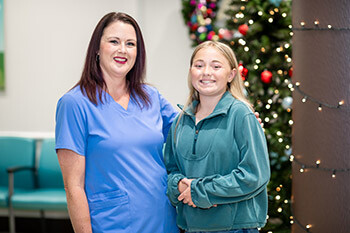
The tiny little girl had just left the intensive care unit at Children’s Health, and Sabrina spent her entire 12-hour shift in Charley’s hospital room, getting to know the family and helping them process next steps for a little girl that had no working kidneys and was on dialysis.
That was more than a decade ago for the nurse, who has spent almost her entire career caring for kids with kidney diseases at Children’s Health. Since then, Sabrina -- along with dozens of other team members -- has watched Charley grow up, as the now-teenager has endured years of dialysis and two kidney transplants.
“Children’s Health isn’t a hospital like anywhere else. We treat our patients like they’re family, and it takes everyone who works here to make that happen,” said Sabrina, a nurse on the nephrology unit. “People want to come here because they know they’re going to get excellent treatment by a staff that cares for them as people.”
Children's Health offers one of the longest-running comprehensive pediatric transplant programs in the nation. Each year, the program serves approximately 500 patients -- performing somewhere around 50 heart, kidney and liver transplants -- and helps recipients continue to thrive well after transplantation.
In 2021, the team celebrated a monumental milestone – the performance of its 1,500th transplant since the program’s inception in 1980 – and continues to provide hope and healing for children and families every day.
The nephrology and pediatric transplant program include a renowned team of experts and ancillary services that offer a multidisciplinary approach to care that supports a child's unique physical, emotional, psychological and developmental needs.
“We know it’s not easy to be in the hospital, and we try to bring a little bit of joy to everything we do,” Sabrina said. “I don’t know if it’s magic, but I try to make any time patients and families have to be here as pleasant as possible.”
These team members like Sabrina don’t just care about Charley’s physical needs. They care about her emotional wellbeing, too. They circled around Charley and sang as she got dialysis on her 13th birthday. Raymond Quigley, M.D., her dialysis doctor, paid Charley a special visit during the holidays to play carols on his violin.
And two days before Christmas last year, Charley, now 13, received her second new kidney from a living adult donor – the ultimate holiday gift.
"Children's Health doesn't just treat the physical issue," said Charley’s grandmother, Rachelle. "They treat the mind, body, soul, emotional health, mental health. … They have a specialty for everything. And it really, really makes a difference."
From nurses and child life specialists to clinical therapists and donors, our team members and generous supporters rally each winter season to bring hope for families in the hospital.
Because together, we can bring magic to kids.
BROOKE DUNGAN, Transplant Coordinator
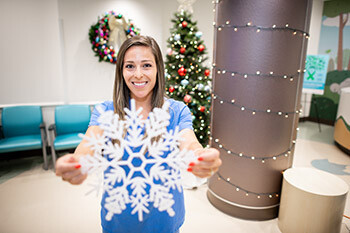
From the time one of our patients on the waitlist gets an offer for a donated kidney, coordinators like me help facilitate the process of getting that kidney to the patient. From the time of transplant to the time the patient “graduates” to an adult hospital, we help oversee most aspects of their care – managing their medications, reviewing their lab work, and so much more.
I was the transplant coordinator on call the week Charley received her second kidney transplant, two days before Christmas last year. I’ve followed her closely from the beginning to help minimize her number of trips to the hospital, discuss her medication and lab monitoring plans and oversee just about everything that happens to her. She had a more complicated transplant course, so I learned her case as best as possible to be sure I wouldn’t miss anything.
When Charley would come to clinic visits, we’d talk about everything from athletic wear and new hairstyles to diet and exercise. Physical activity is really important after transplant, so I showed her how to adjust her Apple watch to make sure she was hitting her walking goals.
As much as I love to see Charley in person, I help bring the magic by making sure I’m doing my best to decrease the frequency in which she has to come to the hospital so she can spend as much time as possible at home enjoying her life after transplant.
CHRISHANNA HARTFORD, Phlebotomist

I gave birth to a premature baby at 23 weeks, and because of that experience and learning how to advocate for my child, it made me want to pursue a career in the health care field.
I see my job as a phlebotomist as the key to the answer for what might be going on beneath the surface for a patient. If you don’t have bloodwork, then doctors are left guessing. But if I do my job right, then they can get some answers for patients and families.
I met Charley about a decade ago after she had her first kidney transplant. She would come into the outpatient clinic once a week to get her blood drawn. I got to know her very well, along with what she does and doesn’t like when caring for her. For example, Charley doesn’t like Band-aids!
Because of my experience with my premature son (who is now 20 years old), families say that I’m a calming presence in the room. They also tell me that I’ve got a gift for making those pokes painless for kids, and that’s magical.
CHRISTIAN GERKEN, Nephrology Patient Care Technician
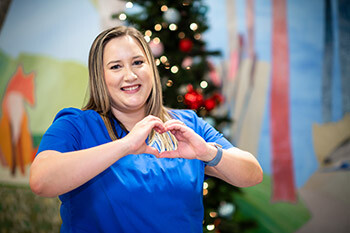
I spend most of my days running from patient room to patient room, making sure our nurses have everything they need to care for kids. I update the whiteboards in each patient’s room, so they know who is taking care of them.
As techs, we’re there for everything from making sure patients have had something to eat and drink to wrapping their IV’s so they can take showers to transporting patients to exams. I keep kids company when their parents have to step out of the room for a moment. I feed babies, change diapers and rock them to sleep. It’s not an easy job, but it’s the patients who make your day better.
I always make sure that when I'm walking through those hospital doors, I’m in a good mood. For the 12 hours that I’m here working my shift, I try to make their hospital experience better.
DEV DESAI, M.D., Ph.D., Chief of Pediatric Transplantation at Children’s Health; The Regents Distinguished Scholar in Medical Research and Professor at UT Southwestern Medical Center
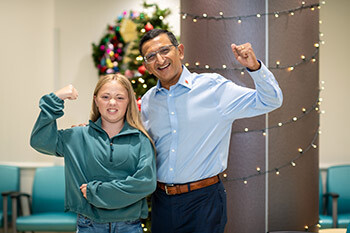
Pediatric transplant has the ability to create a lifelong change for children who have serious illnesses that keep them from being kids. Philosophically, we’re helping give someone a second chance at life.
Kidney and liver failure are life-threatening illnesses, and without a transplant, these patients won’t survive into adulthood. And it’s not because of anything they did. They were born with conditions that cause liver and kidney failure.
Like Charley, my patients have a zest for life. They don’t let things like having an organ transplant or taking medications hold them back. I’m not sure that I bring the magic, but giving kids an opportunity to live a normal childhood is hopefully what I bring to patients.
Transplant is a very resource intensive effort. Patients take medications for life. They have lots of visits here, which disrupts their school. We care for kids from across Texas and from surrounding states, so we try to do things remotely and use technology when we can. But those resources are expensive and philanthropic investments help us care for patients better in that way. We also use support from generous donors to host a camp each year for our patients, which allows them to meet and spend time with kids who have undergone transplants just like them.
ELIZABETH TEKYI, RN, Vascular Access
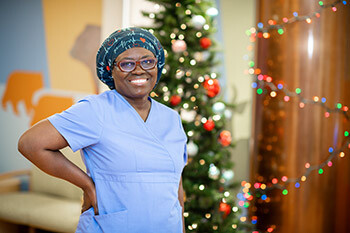
I keep this necklace that says “Best IV Nurse” that Charley made me in my car. I’ve changed cars twice, and it’s come with me each time. I’ve known Charley for several years, and whenever she needs an IV, she’ll ask for me.
Sometimes, we think we are the ones who touch families, but if you let them, the kids will touch you. And Charley really touched me the day she gave me that necklace. I told her that I’d keep it forever.
At the end of the day, my goal is to make sure each child is taken care of, and that I’ve made their poke as painless as possible.
I always explain what I’m going to do to patients first, and they always have a choice. That’s really important to me. These kids are a blessing to me and have humbled me. I’m amazed at how they always have smiles on their faces, and after I insert an IV, they will thank me. They know that we’re here to help them.
Donations help us extend our research so that we can better care for kids. In the years I’ve been doing this, there have been advances in how we give IV’s to kids so that it’s a better experience for them, and a lot of that is because of research. Everyone has a part to play in caring for kids, and donors help support us so that we can continue to do what we do best at the bedside.
KAROLINE RADKA, Child Life Specialist

As a child life specialist, I help make a difference in kids’ lives by helping them overcome fears. It’s my job to see kids before transplant and prepare them for surgery, which can sound like a scary experience. But we help minimize some of those fears.
I always say that I’m a teacher for the hospital and part of my job is helping kids when we have to do hard things here. Surprises are for birthday parties, not the hospital. Children shouldn’t have to experience surprises when they’re at the hospital because it’s their body. I want to prepare them for what’s going to happen to their body.
During the holidays, child life specialists make sure that every kid receives a present through our store, which allows parents and guardians to pick out their own gifts at no cost because they are provided by generous donors.
The work we do would not be possible without philanthropic support. Donors help provide resources for medical play, iPads to support kids through challenging procedures and toys to give to anxious kids. Donations impact the work we do every day.
KELSEY ROGERS, Clinical Therapist, Solid Organ Transplant
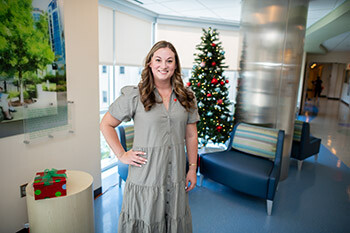
I am a Clinical Therapist embedded within the Solid Organ Transplant team. My goal is to make patients feel safe in an unknown environment. I see patients as young as 2 years old who might be having a difficult time before and after their transplant.
With transplant, there are many added stressors such as new medications and the adjustment of taking care of a new organ. We know that this life altering experience can elicit strong emotions and new behaviors for both children and teens. I am their safe person, who isn’t a friend, family member or medical provider, for kids to process their emotions with and to help them problem-solve as they go through their transplant journey.
In the last several years, the country has faced a mental health crisis. Being able to hire more clinical therapists has made a huge impact on the patients we serve. On the transplant team, they hired me as a second therapist because they saw the need. Now, patients can be seen in-house with their team, rather than being referred out to someone in the community. Since I’m part of the transplant team, I better understand patients’ medical care and can speak to their experience. Getting to work with this population and support kids during this pivotal time in their life is amazing.
LUCY ANTONY, RN, Hemodialysis

I’ve been a nurse here for almost two decades and love to see how patients improve after a dialysis treatment. As a nurse, I play a lot of different roles. I’m an advocate. I’m a teacher. I’m like a mother.
When they’re here for treatment, they’re often sitting in the chair for three to four hours. Donors have helped provide funding for iPads to distract them for that period. They also provide resources to help us celebrate special occasions for kids – birthdays, Halloween and the holidays – which brings a little joy during treatment.
And while they’re here for several hours, I also have a lot of time to talk to them. Sometimes, they’re worried. Sometimes, they’re in pain. My job is to try to make them comfortable and happy.
At the end of the day, if the patient feels better, I feel better. I evaluate myself based on how comfortable I made my patients that day. Did my presence impact that child’s care? Most days, I’m very happy when I go home.
RAYMOND QUIGLEY, MD, Pediatric Nephrologist at Children’s Health and Professor at UT Southwestern Medical Center
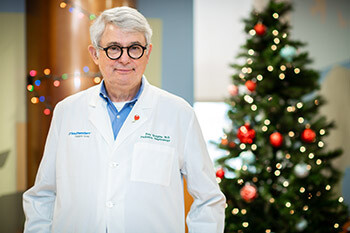
The kidney is the master organ in your body. It regulates everything. And my job is to work with kids who have kidney diseases and kidney failure that requires dialysis to cleanse their blood until they can receive a kidney transplant.
I’ve worked at Children’s Health for several decades, but when I was a resident here, I happened to be on-call during the holidays. I’ve been playing the fiddle for a long time and brought my violin in to play some carols for patients and team members.
Since then, it’s a tradition that I’ve continued during the season. And even other times throughout the year, I’ll play for patients while they’re receiving dialysis treatment or in the ICU after a transplant.
I do this for the patients but also team members who have to work during the holidays. I hope my music cheers them up a little bit and lets them know that they’re going to be OK.
REBECCA HOO, Kidney Donor
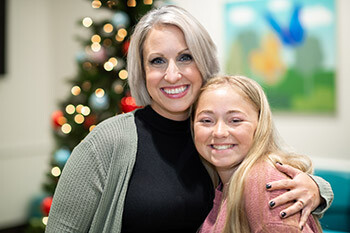
I live in Nebraska now, but when I lived in Texas, I went to the same church as Charley and her family. I’d met Charley a couple of times but didn’t know her well.
One day, I was scrolling on Facebook when I came across a post from a mutual friend saying that Charley was looking for another kidney. A couple weeks later, there was another post, and this time, I learned that Charley and I were the same blood type.
For whatever reason, I could not let this go. I thought about it all the time. I decided there must be a reason that I can’t read about this and forget it. There was a combination of my faith, and that it kept popping up in my head and my heart.
Before the surgery, I spent a week quarantining with Charley and her grandmother, and during that time, I really got to know them. I learned that they have such big hearts. They’re so nice and loving. They did everything to make sure my husband and four kids were able to fly down to be with me for Christmas.
And it was funny because the more time I spent with Charley, the more I realized how similar we are personality-wise. It was like she was a mini-me. It was so bizarre that our kidneys matched because so much of us matched.
I didn’t bring the magic of the holiday season to Charley – I shared it with her. And now, we have this unbreakable bond.
RHYAN BROWN, APRN, PNP-PC, Nephrology Nurse Practitioner at Children’s Health

I first met Charley as a charge nurse on the inpatient unit when she was 18 months old. I cared for her multiple times in preparation for her first transplant.
Then, I went back to school to become a nurse practitioner. This time, I had the opportunity to support Charley as a nurse practitioner in dialysis as she prepared for her second transplant. There are so many team members who’ve have looked after Charley since she was baby. I love being able to offer continuity of care to patients.
Growing up, my cousin was treated here for leukemia as a toddler. This experience sparked my interest in nursing. I then volunteered at Children’s Health as a teenager. I helped in the playrooms and sat with patients when their parents and guardians couldn’t be in the hospital room.
Nurses make the hospital function. Not only do we have medical knowledge about treatments, but we’re good at connecting with patients on a human level. We’re the voice for the patient and family as they navigate difficult situations.
Kids count on us. We count on you.
Give to support innovative research, lifesaving treatments and compassionate care.
Did you enjoy this story?
If you would like to receive an email when new stories like this one are posted to our website, please complete the form below. We won't share your information, and you can unsubscribe any time.

